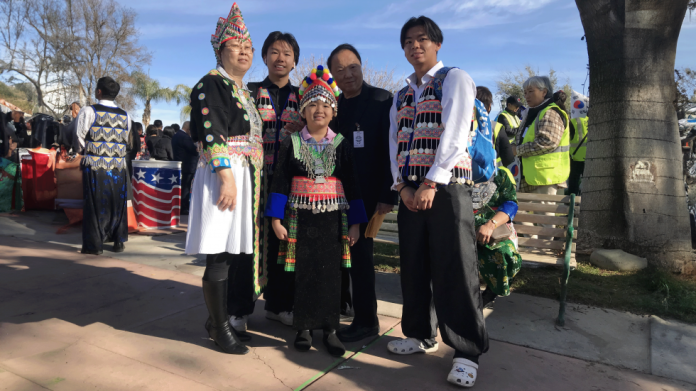A coalition of funders is trying to save journalism, and one of
the first to receive their aid is a little-known website serving
a small ethnic community in Sacramento. Press Forward announced
its first cohort of grant recipients
in October. Of 931
proposals nationwide, only 205 organizations received funds
totaling $20 million. Eighteen grantees were based in California
with only one in the Capital Region: Hmong Daily News.
“Wow! It was just beyond me,” says Macy Yang about when Press
Forward awarded her $100,000 to expand operations. Yang runs a
newsroom of “two and a half,” which includes herself, military
journalist Marc Yablonka and a high
school student. Together they cover the lives of the Hmong
diaspora, who largely came to the U.S. as refugees from Southeast
Asia about 50 years ago.
“We are serving a population that is not being served,” Yang
says. “Our needs, as far as media and information, are not being
met. And so we’re helping to close the gap for the Hmong
community.”
To that end, Yang used the grant money to hire a social media
marketer, who will also contribute articles. She is also looking
to bring on reporters who can write in the Hmong language. Her
goal is to increase the Hmong community’s visibility, platform
their triumphs and make relevant information accessible to them.
An estimated 27,000 Hmong live in the Sacramento metropolitan
area as of 2019, according to the
Pew Research
Center. The last census put the region’s total
population at about two and a half million, meaning there is one
Hmong out of every hundred people living in and around the
state’s capital. While this is a relatively large percentage for
a single Indigenous group — in comparison, American Indian and
Alaska Native residents of any nation make up
1.6 percent of Sacramento
County’s population — a TV station or daily newspaper
covering stories for a wide audience wouldn’t tailor their
content for a group comprising a sliver of their target market.
That’s where ethnic media outlets come in.
Macy Yang is founder of the Hmong Daily News. (Photo courtesy of
Macy Yang)
These publications are typically staffed by
members of a racial, ethnic, linguistic or religious minority who
understand the nuances and priorities of their community and
advocate its needs to the general public. This practice isn’t
new. German, Irish, and other non-English immigrants created
their own newspapers after immigrating to the 13 colonies,
according to the
University of Maryland. Examples of ethnic outlets in
the Capital Region today include Spanish-language television
Univision 19 Sacramento,
The Sacramento Observer, which
has served African-Americans since 1962, the decade-old Slavic Sacramento writing for
Russian and Ukrainian speakers, and most recently, Hmong Daily
News.
Yang on the website commemorates the everyday victories of her
people. She writes up how-to-vote guides for the Hmong and covers
their events. One of her proudest works was “Hmong Women in
Leadership,” a series of profiles on Hmong women serving in
government. “Those are not things that necessarily the Sacramento
Bee may want to cover, but it is an important milestone for us,
an achievement that we want to highlight.” There are a lot of
positive stories in the Hmong Daily News, but Yang doesn’t shy
away from crime coverage and murder trials.
During the pandemic, the newsroom dispelled myths spread
specifically among the Hmong about COVID-19. “There’s just a lot
of misinformation that big outlets were not going to address for
one community versus another,” Yang says. So she stepped up to
share accurate facts reported by Hmong, for Hmong. “Not only do
we tell our story, but we are the platform to give information
out accurately and to decipher what’s correct and what’s
incorrect.”
Yang is passionate about telling the story of her people, who
have a long history. The Hmong originated in China about 4,000
years ago but in the 18th century began migrating en masse to
Southeast Asia, according to the Hmong American Center. The CIA
recruited Hmong soldiers to fight communists in Laos and Vietnam
in what became known as the Secret War. This led to the Hmong to
become persecuted after the U.S. pulled out of the region in the
1970s. These refugees fled their homeland and resettled in the
West, including Yang. She was 4 years old when her family
immigrated from Laos to Wisconsin. They later joined an influx of
Hmong moving to California to farm and escape the cold.
Yang works as a business consultant, but before moving back to
California a few years ago from the Midwest, she freelanced for
the Prescott, Wisconsin-based Hmong Times in her spare time.
She wanted to continue her craft in Sacramento. There is the Hmong radio station KJAY,
but no Hmong newspapers. So she started her own. The onset of a
global pandemic isn’t an ideal time to launch a newspaper, but
that’s the situation Yang found herself in. The Hmong Daily News
launched in March 2020. Originally a twice-monthly print
newspaper found at grocery stores and Hmong-owned businesses, the
news outlet quickly shifted to be online only to cut costs and to
publish news faster.
There have been moments over the past four years when Yang has
struggled. Sometimes she wondered if Hmong Daily News mattered.
“There were times when I just felt like nobody was reading my
news,” Yang says. She always fought off that negativity, and
networking with other journalists through Ethnic Media Services helped.
The San Francisco-based organization provides resources to ethnic
outlets, and it was through them Yang learned of the Press
Forward grant.
Sandy Close serves as its executive director and said ethnic news
outlets have endured despite the difficulty. “People talk about
the death of community journalism, and you almost never see in
those articles references to ethnic media, which has continued
against the odds,” Close says. Often these newspapers and
websites struggle with financial stability. It can be hard to
garner advertisement dollars from businesses and government
agencies because their communities are small and dispersed.
“There was a collective shrug, if indeed ad agencies even knew
they existed.”
Things have begun to change. In September, Governor Gavin Newsom
signed
Assembly Bill 1511
into law, which aims to bolster ethnic media across California.
State agencies and departments that spend money on ads moving
forward will develop plans to increase money spent on outlets
like Hmong Daily News. Close said the importance of ethnic media
goes beyond just covering news. It serves as an advocating voice
for their community. Yang wants broader Sacramento to learn about
the Hmong through her reporting.
“Our stories are not unique,” Yang says, “Our experience is not
so unique to the immigrant or the refugee story, but we want the
greater community out there to understand who we are and where we
came from, what our values are and what stories we want to be
able to tell.”
Correction Nov. 22, 2024: A previous version of this article
stated that Hmong Daily News originally printed twice weekly. It
printed twice monthly.
–
Subscribe to the
Comstock’s newsletter today.







